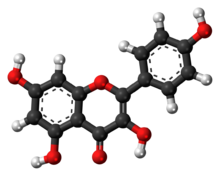Chemistry:Kaempferol

| |

| |
| Names | |
|---|---|
| IUPAC name
3,4′,5,7-Tetrahydroxyflavone
| |
| Systematic IUPAC name
3,5,7-trihydroxy-2-(4-hydroxyphenyl)-4H-1-benzopyran-4-one | |
| Other names
Kaempherol; Robigenin; Pelargidenolon; Rhamnolutein; Rhamnolutin; Populnetin; Trifolitin; Kempferol; Swartziol
| |
| Identifiers | |
3D model (JSmol)
|
|
| ChEBI | |
| ChEMBL | |
| ChemSpider | |
| KEGG | |
PubChem CID
|
|
| UNII | |
| |
| |
| Properties | |
| C15H10O6 | |
| Molar mass | 286.23 g/mol |
| Density | 1.688 g/mL |
| Melting point | 276–278 °C |
Except where otherwise noted, data are given for materials in their standard state (at 25 °C [77 °F], 100 kPa). | |
| Infobox references | |
Kaempferol (3,4′,5,7-tetrahydroxyflavone) is a natural flavonol, a type of flavonoid, found in a variety of plants and plant-derived foods including kale, beans, tea, spinach, and broccoli.[1] Kaempferol is a yellow crystalline solid with a melting point of 276–278 °C (529–532 °F). It is slightly soluble in water and highly soluble in hot ethanol, ethers, and DMSO. Kaempferol is named for 17th-century German naturalist Engelbert Kaempfer.[2]
Natural occurrence
Kaempferol is a secondary metabolite found in many plants, plant-derived foods, and traditional medicines.[3] Its flavor is considered bitter.
In plants and food
Kaempferol is common in Pteridophyta, Pinophyta, and Angiospermae. Within Pteridophyta and Pinophyta, kaempferol has been found in diverse families. Kaempferol has also been identified in Dicotyledons and Monocotyledons of Angiosperms.[3] The total average intake of flavonols and flavones in a normal diet is estimated as 23 mg/day, to which kaempferol contributes approximately 17%.[4] Common foods that contain kaempferol include: apples,[5] grapes,[5] tomatoes,[5] green tea,[5] potatoes,[4] onions,[3] broccoli,[3] Brussels sprouts,[3] squash,[3] cucumbers,[3] lettuce,[3] green beans,[3] peaches,[3] blackberries,[3] raspberries,[3] and spinach.[3] Plants that are known to contain kaempferol include Aloe vera,[3] Coccinia grandis,[3] Cuscuta chinensis,[6] Euphorbia pekinensis,[3] Glycine max,[3] Hypericum perforatum,[3] Pinus sylvestris,[7] Moringa oleifera,[8] Rosmarinus officinalis,[3] Sambucus nigra,[3] and Toona sinensis,[3] and Ilex.[3] It also is present in endive.[9]
| Foods | Kaempferol
(mg/100g) |
|---|---|
| capers, raw | 259[10] |
| saffron | 205[10] |
| capers, canned | 131[10] |
| arugula, raw | 59[10] |
| kale, raw | 47[10] |
| mustard greens, raw | 38[10] |
| ginger | 34[10] |
| common bean, raw | 26[10] |
| chinese cabbage, raw | 23[10] |
| dill, fresh | 13[10] |
| garden cress, raw | 13[10] |
| chive, raw | 10[10] |
| dock, raw | 10[10] |
| endive, raw | 10[10] |
| collard, raw | 9[10] |
| broccoli, raw | 8[10] |
| fennel leaves | 7[10] |
| goji berry, dried | 6[10] |
| drumstick leaves, raw | 6[10] |
| chard, raw | 4[10] |
Biosynthesis
The biosynthesis of kaempferol occurs in four major steps:[3]
- Phenylalanine is converted into 4-coumaroyl-CoA
- 4-coumaroyl-CoA combines with three molecules of malonyl-coA to form naringenin chalcone (tetrahydroxychalcone) through the action of the enzyme chalcone synthase
- Naringenin chalcone is converted to naringenin and then a hydroxyl group is added to form dihydrokaempferol
- Dihydrokaempferol has a double bond introduced into it to form kaempferol
The amino acid phenylalanine is formed from the Shikimate pathway, which is the pathway that plants use in order to make aromatic amino acids. This pathway is located in the plant plastid, and is the entry to the biosynthesis of phenylpropanoids.[11]
The phenylpropanoid pathway is the pathway that converts phenylalanine into tetrahydroxychalcone. Flavonols, including kaempferol, are products of this pathway.[12]
Notes
- ↑ Holland, Thomas M.; Agarwal, Puja; Wang, Yamin; Leurgans, Sue E.; Bennett, David A.; Booth, Sarah L.; Morris, Martha Clare (2020-01-29). "Dietary flavonols and risk of Alzheimer dementia" (in en). Neurology 94 (16): e1749–e1756. doi:10.1212/WNL.0000000000008981. ISSN 0028-3878. PMID 31996451.
- ↑ Kaempferol at Merriam-Webster.com; retrieved October 20, 2017
- ↑ 3.00 3.01 3.02 3.03 3.04 3.05 3.06 3.07 3.08 3.09 3.10 3.11 3.12 3.13 3.14 3.15 3.16 3.17 3.18 3.19 3.20 3.21 3.22 "A review on the dietary flavonoid kaempferol". Mini Reviews in Medicinal Chemistry 11 (4): 298–344. April 2011. doi:10.2174/138955711795305335. PMID 21428901.
- ↑ 4.0 4.1 "Health-promoting components of fruits and vegetables in the diet". Advances in Nutrition 4 (3): 384S–92S. May 2013. doi:10.3945/an.112.003517. PMID 23674808.
- ↑ 5.0 5.1 5.2 5.3 "Anti-cancer Effect and Underlying Mechanism(s) of Kaempferol, a Phytoestrogen, on the Regulation of Apoptosis in Diverse Cancer Cell Models". Toxicological Research 29 (4): 229–34. December 2013. doi:10.5487/TR.2013.29.4.229. PMID 24578792.
- ↑ "Cuscuta chinensis Lam.: A systematic review on ethnopharmacology, phytochemistry and pharmacology of an important traditional herbal medicine". Journal of Ethnopharmacology 157 (C): 292–308. November 2014. doi:10.1016/j.jep.2014.09.032. PMID 25281912.
- ↑ "Pine bark and green tea concentrated extracts: antioxidant activity and comprehensive characterization of bioactive compounds by HPLC-ESI-QTOF-MS". International Journal of Molecular Sciences 15 (11): 20382–402. November 2014. doi:10.3390/ijms151120382. PMID 25383680.
- ↑ "Moringa oleifera: a food plant with multiple medicinal uses". Phytotherapy Research 21 (1): 17–25. January 2007. doi:10.1002/ptr.2023. PMID 17089328.
- ↑ "Absorption of kaempferol from endive, a source of kaempferol-3-glucuronide, in humans". European Journal of Clinical Nutrition 58 (6): 947–54. June 2004. doi:10.1038/sj.ejcn.1601916. PMID 15164116.
- ↑ 10.00 10.01 10.02 10.03 10.04 10.05 10.06 10.07 10.08 10.09 10.10 10.11 10.12 10.13 10.14 10.15 10.16 10.17 10.18 10.19 "USDA Database for the Flavonoid Content of Selected Foods, Release 3". U.S. Department of Agriculture. 2011. http://www.ars.usda.gov/SP2UserFiles/Place/12354500/Data/Flav/Flav_R03.pdf.
- ↑ "Phenylpropanoid biosynthesis". Molecular Plant 3 (1): 2–20. January 2010. doi:10.1093/mp/ssp106. PMID 20035037.
- ↑ "Advanced knowledge of three important classes of grape phenolics: anthocyanins, stilbenes and flavonols". International Journal of Molecular Sciences 14 (10): 19651–69. September 2013. doi:10.3390/ijms141019651. PMID 24084717.
External links
 |

